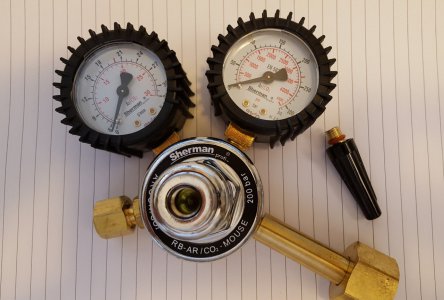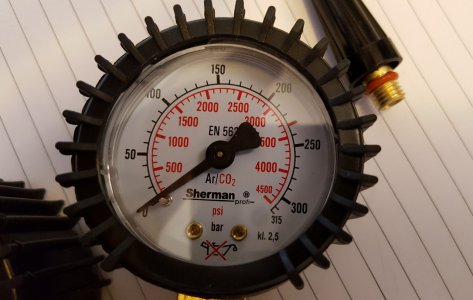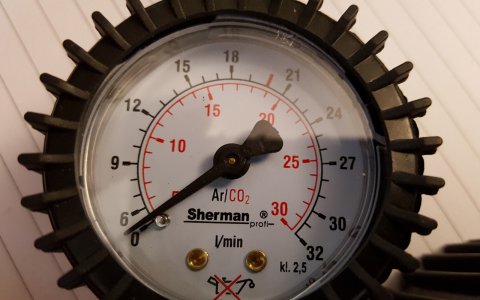-
Welcome back Guest! Did you know you can mentor other members here at H-M? If not, please check out our Relaunch of Hobby Machinist Mentoring Program!
You are using an out of date browser. It may not display this or other websites correctly.
You should upgrade or use an alternative browser.
You should upgrade or use an alternative browser.
Water-Cooled TIG connectors confusion
- Thread starter graham-xrf
- Start date
Get a torch flow meter, which will be a useful way to make sure you have the desired flow where it counts:


Profax Welding Gas Flow Meter Tester 50020 for sale online | eBay
Find many great new & used options and get the best deals for Profax Welding Gas Flow Meter Tester 50020 at the best online prices at eBay! Free shipping for many products!
www.ebay.com
- Joined
- May 27, 2016
- Messages
- 3,479
Catching up on this. The nice man at CK shop arranged the return of the CK20 torch, DINSO, and everything. He was surprised you could get a combination that would not fit itself. A whole replacement set has arrived, with DINSO, and extra adapter to regulator. Everything brand new, DINSO plastic pack squeezed into the same box. This time, it fits itself 
The water cooler is coming together. I got some 1.6mm and 2.4mm 2% lanthanated (blue) tungsten electrodes. There is a bunch of smaller stuff to get (collets, cups, etc). One thing that has got me curious are the long(ish) black back caps. Presumably to cover the unused bit of electrode that sticks out the back, they seem to be sold in multiples of 5. So do they often break, or wear out somehow?
The water cooler is coming together. I got some 1.6mm and 2.4mm 2% lanthanated (blue) tungsten electrodes. There is a bunch of smaller stuff to get (collets, cups, etc). One thing that has got me curious are the long(ish) black back caps. Presumably to cover the unused bit of electrode that sticks out the back, they seem to be sold in multiples of 5. So do they often break, or wear out somehow?
You mentioned a two gauge regulator. If the low pressure side gauge is really a flowmeter, marked in cfh, that is all you need. Or, if you have doubts, buy a cheap peashooter, as mentioned above. Or, if funds are really tight, use a sandwich bag, but without the zip lock closure on top. They close more easily. Or if funds are really, really tight, use a poly vegetable bag. Don't bother cleaning the little pieces of vegetable out of it, since they don't affect the calibration. Or, if funds are really, really, really tight, use a pair of scissors to cut a few inches off the top of the bag, so it takes less gas to fill. You have to be quicker on the stopwatch though.
- Joined
- Jun 17, 2016
- Messages
- 350
I would also recommend some 3.2mm 2% La tungsten. The advantage of a larger tungsten (besides current carrying capability) is that the point stays sharper, longer. Especially with 2% La; it typically erodes a little bit faster than say 2% Th.
Back-cap's can break if you accidentally drop the torch, so keep all the ones you got.
As for the flow-meter or dial-type regulator, think/test empirically: using a standard #7 cup, 4mm arc length, set to ~20 CFH create a ¼" (~6mm) diameter weld pool in the flat position by holding your arm/hand steady, and have the argon tank within the other arm's reach. Turn down the flow until you start to get the tiniest bit of sparks/porosity (don't go too far or you'll make it "pop" and spit up molten steel on to the tig torch cup and tungsten). Then you can see what flow on the regulator/meter is the no-go zone, and bump it up from there, say 3-4 CFH. That will clear the no-go zone, and use the bare minimum amount of argon with a good safety net. Of course this would only be valid for that particular arc length, and welding position but it will be pretty close for others; some need more (like an outside corner joint), some need less (like an inside corner joint).
Back-cap's can break if you accidentally drop the torch, so keep all the ones you got.
As for the flow-meter or dial-type regulator, think/test empirically: using a standard #7 cup, 4mm arc length, set to ~20 CFH create a ¼" (~6mm) diameter weld pool in the flat position by holding your arm/hand steady, and have the argon tank within the other arm's reach. Turn down the flow until you start to get the tiniest bit of sparks/porosity (don't go too far or you'll make it "pop" and spit up molten steel on to the tig torch cup and tungsten). Then you can see what flow on the regulator/meter is the no-go zone, and bump it up from there, say 3-4 CFH. That will clear the no-go zone, and use the bare minimum amount of argon with a good safety net. Of course this would only be valid for that particular arc length, and welding position but it will be pretty close for others; some need more (like an outside corner joint), some need less (like an inside corner joint).
- Joined
- May 27, 2016
- Messages
- 3,479
OK - two things going on here. One is about flowmeter, which is OK. The other is about a novel use of plastic bags as a ghetto flow-meter device. I am having a bit of a hard time visualizing them, but respect and kudos to those who get something like that to work - in a pinch maybe.You mentioned a two gauge regulator. If the low pressure side gauge is really a flowmeter, marked in cfh, that is all you need. Or, if you have doubts, buy a cheap peashooter, as mentioned above. Or, if funds are really tight, use a sandwich bag, but without the zip lock closure on top. They close more easily. Or if funds are really, really tight, use a poly vegetable bag. Don't bother cleaning the little pieces of vegetable out of it, since they don't affect the calibration. Or, if funds are really, really, really tight, use a pair of scissors to cut a few inches off the top of the bag, so it takes less gas to fill. You have to be quicker on the stopwatch though.
Regarding the regulator gauges, I have just had a careful look at the gauge dials, which I might call "Eastern bloc aspirational". They look rugged enough, an impression conveyed by the ribbed rubber/plastic covers. The font is regrettably small enough to be quite at home in a USA insurance contract, but the key thing to know is that the second gauge is a flowmeter! At least, that is what is implied by "l/min", even though the "L" is lowercase.
The construction of the second gauge is of the shape and style of a pressure gauge, but I have to hope it has some differential arrangement down in the innards that makes it capable of measuring flow. The dials are marked in two colours, but in a confusing way. On the pressure dial, red is PSI and black is in bar, which I am more familiar with. Unfortunately, the initial clear use of colour code then gets thrown into some confusion by seeing "Ar/CO2". I get what you would call a "peashooter". At least one can see how that style works!
The flow-meter calibrations don't make much sense
We can go with a known 20 CFH means 9.44 litres/minute. There is no flow units correspondence between the reds and the blacks. Just about any TIG stuff one could get up to would only move the reading into the first 25% of scale.



I just know you guys must think I am close to nuts, but I can't help the way I think, and I can get kinda skeptical about stuff when I don't know exactly what it does. I absolutely know there will be no problem in getting something going, even if the gauge were not there at all, or substituted with an @ericc plastic zip-bag special, but you have to admit the flowmeter dial is just a tad strange!
Last edited:
- Joined
- May 27, 2016
- Messages
- 3,479
This seems to be a great way to check out and get used to what works relative to what the gauges say. I now have a 20L cylinder of pure Argon (at 200 bar) devoted to TIG. The other cylinder, having 5% CO2 in it, is for MIG. The gas vendor will take any mix, and supply something different, but I opted for the two bottles.I would also recommend some 3.2mm 2% La tungsten. The advantage of a larger tungsten (besides current carrying capability) is that the point stays sharper, longer. Especially with 2% La; it typically erodes a little bit faster than say 2% Th.
Back-cap's can break if you accidentally drop the torch, so keep all the ones you got.
As for the flow-meter or dial-type regulator, think/test empirically: using a standard #7 cup, 4mm arc length, set to ~20 CFH create a ¼" (~6mm) diameter weld pool in the flat position by holding your arm/hand steady, and have the argon tank within the other arm's reach. Turn down the flow until you start to get the tiniest bit of sparks/porosity (don't go too far or you'll make it "pop" and spit up molten steel on to the tig torch cup and tungsten). Then you can see what flow on the regulator/meter is the no-go zone, and bump it up from there, say 3-4 CFH. That will clear the no-go zone, and use the bare minimum amount of argon with a good safety net. Of course this would only be valid for that particular arc length, and welding position but it will be pretty close for others; some need more (like an outside corner joint), some need less (like an inside corner joint).
OK on the recommending 3.2mm La Tungsten. So far I have ordered 10 x 1.6mm, and 10 x 2.4mm so far. The welder is rated 200A at 45% duty cycle, which is why I thought 3.2mm might lay on a bit lumpy, even if I had it maxed out! For 4mm to 6mm thick joints, I guess it would take all of the 200A. The continuous 100% rating is 155A. This is OK by me. I can quite believe that I could spend 55% of the cycle time between weld starts either grieving over, or admiring the joints. I also think I am going to expend quite a lot of gas just practicing on any and every bit of loose metal in the place!
Just to get a look at consumables available, I have been checking out the offerings from Amazon and eBay. Total gazillions of combinations! The advice from the "The Fabrication Series" dude (Justin), in the link provided by @Lo-Fi is to learn to weld with the "standard" style before getting stuff like gas lenses, and stubbies. I just think that if the better flow and maybe up to a third saving on wasted gas is to be had with that good stuff, why use any other?
Last edited:
Your regulator is actually a flowmeter. See the red line on the black scale? Set it to that number, and you'll have a good start. Of course, General Zod is correct about setting the argon to a minimum value for a clean weld for the situation you are in. The nice thing about the dial flowmeters is that you can set them with the torch off. The rotameters are actual flow gauges (the ones with the ball in them). You need to set them with the torch on.
I said don't use zip-lock bags. They are too expensive. Just the cheap sandwich bags with the flap are fine. The medium bags hold almost a liter. At 20 lpm, they will fill in a little less than 3 seconds. If you are really picky, you can inflate them in a full bucket of water and measure the water that spills out over the rim. If you are really tight on funds, you can pour the water on the garden or water the plants. This is difficult to do with a zip-lock bag, since it is hard to seal the top over the end of the torch. The zip-lock bags also cost slightly more.
I said don't use zip-lock bags. They are too expensive. Just the cheap sandwich bags with the flap are fine. The medium bags hold almost a liter. At 20 lpm, they will fill in a little less than 3 seconds. If you are really picky, you can inflate them in a full bucket of water and measure the water that spills out over the rim. If you are really tight on funds, you can pour the water on the garden or water the plants. This is difficult to do with a zip-lock bag, since it is hard to seal the top over the end of the torch. The zip-lock bags also cost slightly more.
